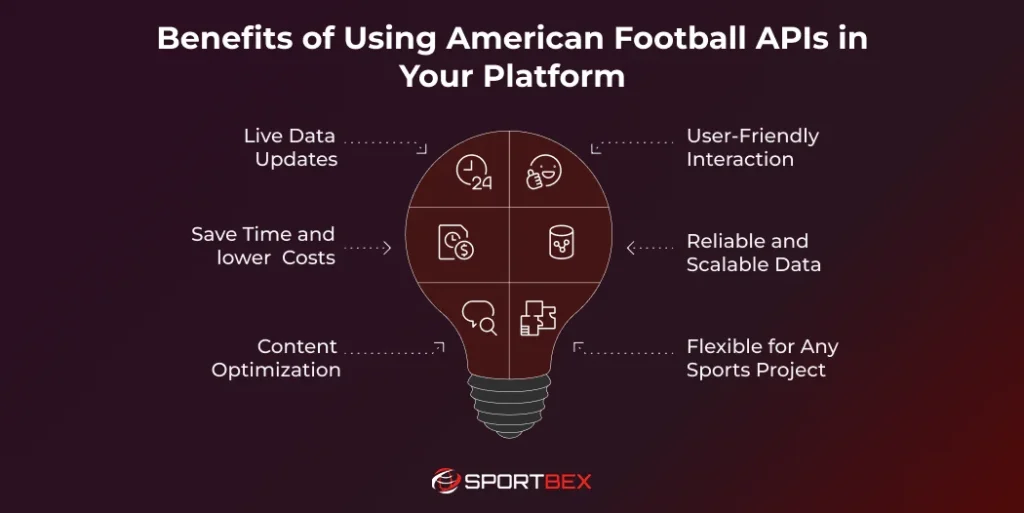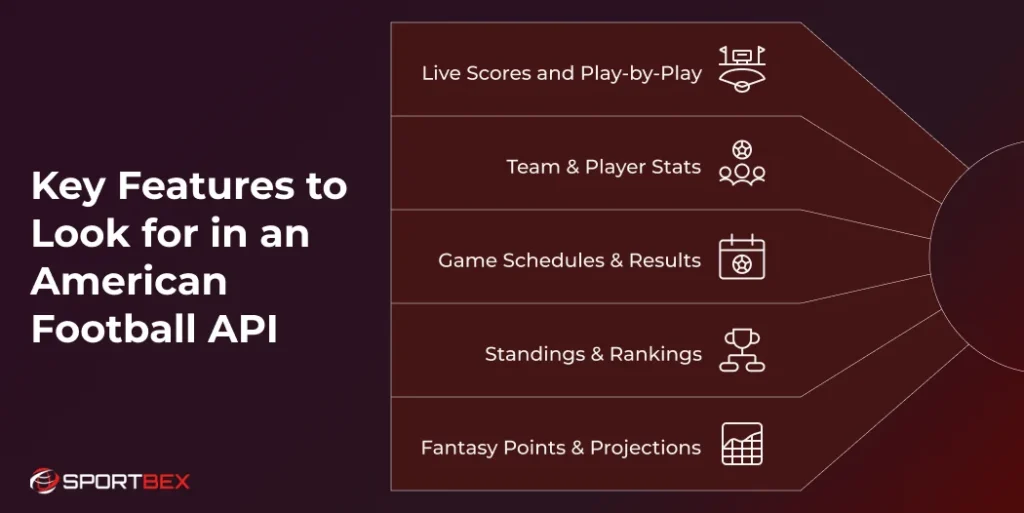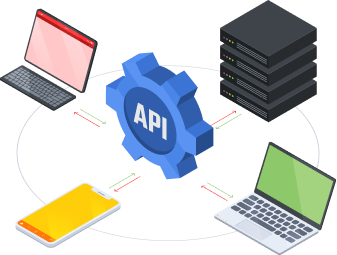American football is one of the most popular sports in the world, with millions of fans following NFL games and college matchups every season. If you’re building a sports platform, fantasy app, or media site, having reliable and up-to-date football data is key to keeping your users engaged.
The challenge is getting accurate, reliable data like live scores, player stats, team performance, and historical records. Collecting this data manually takes a lot of time and can lead to errors while building your own system is costly and hard to maintain. This is where an American Football API becomes valuable—it provides structured, real-time data that’s easy to integrate into your platform, saving time and reducing complexity.
When building a sports-based application, knowing how to integrate American Football APIs into your platform can significantly speed up development and enhance overall performance. These APIs offer structured access to rich football databases using easy-to-implement programming interfaces.
What Is an American Football API?
An American Football API connects your app to detailed football databases, allowing easy access to organized data. These APIs gather information from official leagues, stats services, and trusted sports networks.
They are a game-changer for developers looking to create Fantasy sports apps, fantasy leagues, or betting platforms. A football API for developers allows seamless integration, enabling you to provide users with a rich, interactive experience. You can access details about games, players, teams, seasons, real-time updates, historical stats, injury reports, and even weather conditions, all in one place.
Modern APIs often support both professional leagues like the NFL and college football conferences, offering different endpoints for various data types. Some providers specialize in specific areas such as a football metrics API for fantasy football, while others offer comprehensive coverage across multiple sports categories.
Why Use American Football APIs in Your Sports Platform?
Sports platforms require constant data updates to maintain user engagement and provide valuable insights. American football generates enormous amounts of statistical information during each game, from basic scoring plays to advanced analytics like yards after catch or quarterback pressure rates, which can be efficiently accessed through an advanced football stats API.
Building internal systems to collect and process this data involves substantial technical challenges. You need reliable data sources, real-time processing capabilities, error handling mechanisms, and ongoing maintenance to ensure accuracy. This approach diverts development resources from core platform features that directly impact user satisfaction.
American Football APIs eliminate these technical barriers while providing professional-grade data quality. Established providers invest heavily in data accuracy, server infrastructure, and real-time processing capabilities that individual developers cannot easily replicate.
Benefits of Using American Football APIs in Your Platform

Live Data Updates
American football live score API services deliver game information within seconds of official scoring plays. This real-time capability, powered by a reliable sports data API, keeps users engaged during active games and provides the immediate gratification that modern sports fans expect.
Live updates include scoring plays, possession changes, injury updates, and timeout information. Advanced APIs also provide play-by-play descriptions, down and distance data, and field position tracking that enables rich visualization features.
User-Friendly Interaction
Well-designed APIs make integration easier with clear instructions, consistent response formats, and simple structures. Many providers also offer tools for popular programming languages to save time and reduce mistakes.
Interactive documentation platforms allow developers to test API calls directly in their browsers, exploring available data fields and response formats before writing production code. This hands-on approach accelerates development and reduces integration friction.
Save Time and Lower Costs
Buying API access is much cheaper than building your own system to collect data. Think about the costs of hiring experts, running servers, making deals to get data, and following sports league rules.
APIs also reduce time-to-market for new features. Instead of spending months developing data collection systems, developers can implement comprehensive football data within days or weeks, allowing faster response to user demands and market opportunities.
Reliable and Scalable Data
Professional API providers maintain redundant systems, data backup sources, and automated quality checks that ensure consistent service availability. They handle traffic spikes during popular games and provide performance guarantees through service level agreements.
Scalability becomes automatic as your platform grows. APIs can handle requests from small applications with hundreds of users or enterprise platforms serving millions of requests daily, adjusting infrastructure capacity based on actual usage patterns.
Content Optimization
Detailed football data helps create better content and personalized user experiences. With an American football stats API, you can access past performance data to explore trends, compare players, and even make predictions.
This data depth allows platforms to create unique content experiences, from automated game recaps to personalized player recommendations based on user preferences and fantasy team compositions.
Flexible for Any Sports Project
Modern APIs support diverse use cases through flexible endpoint designs and customizable response formats. Whether building a simple scoreboard widget or a comprehensive analytics dashboard, APIs provide appropriate data granularity and update frequencies.
Integration flexibility extends to different platform types, from mobile applications requiring lightweight JSON responses to enterprise systems needing bulk data transfers and custom formatting options.
Key Features to Look for in an American Football API

Live Scores and Play-by-Play
A good football API should give you real-time score updates and detailed play information. Choose a provider that updates scores every few seconds during games and includes play-by-play details like player names, yards gained, and game situations.
Quality APIs provide structured play data that enables advanced features like drive summaries, red zone efficiency tracking, and momentum analysis. This granular information, delivered through real-time sports data, supports both casual fan interfaces and sophisticated analytical applications.
Team & Player Stats
Statistical coverage should include basic stats like rushing yards and passing touchdowns, as well as advanced data like quarterback rating, yards after contact, and performance in different situations.
Player statistics should cover career records, seasonal performance, and game-by-game breakdowns. Team data should include offensive and defensive rankings, historical performance against different opponents, and home versus away performance splits.
Game Schedules & Results
American football schedule API functionality must provide accurate game timing, venue information, and broadcast details. This includes regular-season games, playoff brackets, and bowl game schedules for college football.
Historical results should include final scores, attendance figures, weather conditions, and key statistical summaries. This historical context enables trend analysis and helps users understand team performance patterns over time.
Standings & Rankings
Current season standings with playoff implications, conference rankings, and bowl eligibility status provide essential context for individual game results. APIs should calculate these rankings automatically based on current season results and league tiebreaker rules.
Historical standings data enables year-over-year comparisons and long-term trend analysis, supporting content creation and user engagement features that extend beyond current season information.
Fantasy Points & Projections
Fantasy Sports API integration requires scoring system flexibility to accommodate different league configurations and custom scoring rules. Quality providers offer multiple fantasy scoring formats and player projection models based on historical performance and matchup analysis.
Weekly projections, injury impact assessments, and bye week tracking help fantasy platform users make informed decisions throughout the season.
Simple Steps to Guide the Integration of the American Football API
Step 1: Select an API Provider
Research available providers by comparing data coverage, update frequencies, pricing structures, and technical support quality. Consider factors like historical data depth, international coverage if needed, and integration complexity for your specific use case.
Evaluate free trial options and sandbox environments that allow testing without commitment. Review documentation quality and examine sample responses to ensure data formats match your application requirements.
Step 2: Create an Account and Get Your API Key
Registration processes typically require basic contact information and intended use case descriptions. Some providers implement approval workflows for commercial applications or high-volume usage scenarios.
API keys serve as authentication tokens and usage tracking mechanisms. Store these keys securely and implement proper rotation policies to maintain account security throughout your application lifecycle.
Step 3: Follow the Instructions
Comprehensive documentation review prevents common integration mistakes and helps identify optimal endpoints for your specific requirements. Pay attention to rate-limiting policies, error handling recommendations, and best practices for efficient data retrieval.
Most providers offer code examples in multiple programming languages, along with detailed parameter descriptions and response field explanations that accelerate implementation efforts.
Step 4: Make Your Request
Start with simple GET requests to basic endpoints like team listings or current standings before implementing complex queries. Use tools like Postman or curl to test API responses and verify data accuracy before writing application code.
Implement proper error handling for network timeouts, invalid responses, and rate limit exceeded scenarios. These edge cases occur regularly in production environments and require graceful handling to maintain user experience quality.
Step 5: Display Response Data
Parse JSON responses carefully, implementing data validation to handle missing fields or unexpected formats. Create flexible display templates that accommodate varying data availability across different games and seasons.
Consider implementing caching strategies for relatively static data like team information and historical statistics to reduce API usage costs and improve application performance.
Step 6: Integration
Incorporate API calls into your application architecture using appropriate design patterns like service layers or repository patterns that separate data retrieval logic from presentation code.
Implement monitoring and logging systems to track API usage, response times, and error rates. This operational visibility helps identify performance issues and optimize integration efficiency over time.
Step 7: Test the Data Flow
Comprehensive testing should cover various scenarios, including active games, completed games, off-season periods, and error conditions. Verify that your application handles data updates gracefully without disrupting the user experience.
Load testing ensures your integration performs adequately during high-traffic periods like playoff games or fantasy draft seasons when user activity peaks significantly.
Get a Ready-Made Platform On Rent.
Get Started Today
Conclusion
Adding American Football APIs to your platform can make a big difference in how users enjoy your app. These tools give you access to real-time scores, player stats, match updates, and more — without having to build everything from scratch.
They help you save time on development, reduce backend work, and keep your data accurate and up to date. Whether you’re creating a fantasy football app, sports website, or stats dashboard, the right football API combined with reliable sports data feeds will help you deliver content faster and more reliably.
Look for the best American sports API and American Football APIs that are easy to use, well-documented, and trusted by other developers. With smart platform integration, you can build a stronger, smoother user experience that keeps your users engaged and informed.
Frequently Asked Questions
You can start by selecting a trusted API provider, signing up to get an API key, and following their documentation to connect it to your site.
Yes, many API providers offer flexible plans that work well for both small projects and growing platforms.
You can access live scores, match schedules, team stats, player profiles, standings, and play-by-play game details.
Most premium APIs offer real-time or near-real-time updates, ensuring your platform always shows the latest football information.
Yes, many developers use football APIs to power fantasy sports platforms, live dashboards, or betting insights — depending on the provider's terms.
Recent Blog
Top American Football API Providers for Real-Time Stats
October 9, 2025
 8 min
8 min
How to Integrate a Horse Racing Leaderboard in Your App
October 8, 2025
 9 min
9 min








